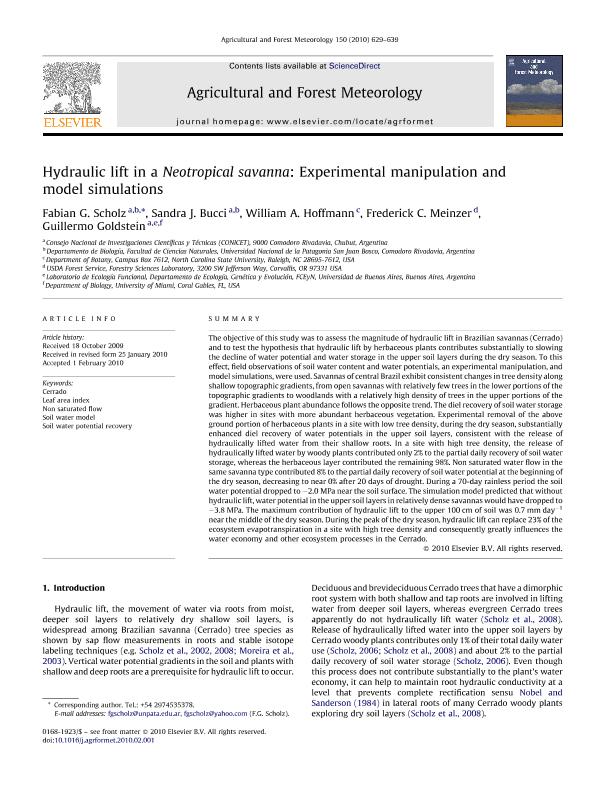Mostrar el registro sencillo del ítem
dc.contributor.author
Scholz, Fabian Gustavo

dc.contributor.author
Bucci, Sandra Janet

dc.contributor.author
Hoffmann, William A.
dc.contributor.author
Meinzer, Frederick C.
dc.contributor.author
Goldstein, Guillermo Hernan

dc.date.available
2019-01-25T21:14:09Z
dc.date.issued
2010-04
dc.identifier.citation
Scholz, Fabian Gustavo; Bucci, Sandra Janet; Hoffmann, William A.; Meinzer, Frederick C.; Goldstein, Guillermo Hernan; Hydraulic lift in a Neotropical savanna: Experimental manipulation and model simulations; Elsevier Science; Agricultural And Forest Meteorology; 150; 4; 4-2010; 629-639
dc.identifier.issn
0168-1923
dc.identifier.uri
http://hdl.handle.net/11336/68692
dc.description.abstract
The objective of this study was to assess the magnitude of hydraulic lift in Brazilian savannas (Cerrado) and to test the hypothesis that hydraulic lift by herbaceous plants contributes substantially to slowing the decline of water potential and water storage in the upper soil layers during the dry season. To this effect, field observations of soil water content and water potentials, an experimental manipulation, and model simulations, were used. Savannas of central Brazil exhibit consistent changes in tree density along shallow topographic gradients, from open savannas with relatively few trees in the lower portions of the topographic gradients to woodlands with a relatively high density of trees in the upper portions of the gradient. Herbaceous plant abundance follows the opposite trend. The diel recovery of soil water storage was higher in sites with more abundant herbaceous vegetation. Experimental removal of the above ground portion of herbaceous plants in a site with low tree density, during the dry season, substantially enhanced diel recovery of water potentials in the upper soil layers, consistent with the release of hydraulically lifted water from their shallow roots. In a site with high tree density, the release of hydraulically lifted water by woody plants contributed only 2% to the partial daily recovery of soil water storage, whereas the herbaceous layer contributed the remaining 98%. Non saturated water flow in the same savanna type contributed 8% to the partial daily recovery of soil water potential at the beginning of the dry season, decreasing to near 0% after 20 days of drought. During a 70-day rainless period the soil water potential dropped to -2.0 MPa near the soil surface. The simulation model predicted that without hydraulic lift, water potential in the upper soil layers in relatively dense savannas would have dropped to -3.8 MPa. The maximum contribution of hydraulic lift to the upper 100 cm of soil was 0.7 mm day-1 near the middle of the dry season. During the peak of the dry season, hydraulic lift can replace 23% of the ecosystem evapotranspiration in a site with high tree density and consequently greatly influences the water economy and other ecosystem processes in the Cerrado.
dc.format
application/pdf
dc.language.iso
eng
dc.publisher
Elsevier Science

dc.rights
info:eu-repo/semantics/openAccess
dc.rights.uri
https://creativecommons.org/licenses/by-nc-sa/2.5/ar/
dc.subject
Cerrado
dc.subject
Leaf Area Index
dc.subject
Non Saturated Flow
dc.subject
Soil Water Model
dc.subject
Soil Water Potential Recovery
dc.subject.classification
Otras Ciencias Biológicas

dc.subject.classification
Ciencias Biológicas

dc.subject.classification
CIENCIAS NATURALES Y EXACTAS

dc.title
Hydraulic lift in a Neotropical savanna: Experimental manipulation and model simulations
dc.type
info:eu-repo/semantics/article
dc.type
info:ar-repo/semantics/artículo
dc.type
info:eu-repo/semantics/publishedVersion
dc.date.updated
2019-01-25T13:40:51Z
dc.journal.volume
150
dc.journal.number
4
dc.journal.pagination
629-639
dc.journal.pais
Países Bajos

dc.journal.ciudad
Amsterdam
dc.description.fil
Fil: Scholz, Fabian Gustavo. Consejo Nacional de Investigaciones Científicas y Técnicas. Oficina de Coordinación Administrativa Ciudad Universitaria. Instituto de Ecología, Genética y Evolución de Buenos Aires. Universidad de Buenos Aires. Facultad de Ciencias Exactas y Naturales. Instituto de Ecología, Genética y Evolución de Buenos Aires; Argentina. Universidad Nacional de la Patagonia. Facultad de Ciencias Naturales. Departamento de Biología; Argentina
dc.description.fil
Fil: Bucci, Sandra Janet. Consejo Nacional de Investigaciones Científicas y Técnicas. Oficina de Coordinación Administrativa Ciudad Universitaria. Instituto de Ecología, Genética y Evolución de Buenos Aires. Universidad de Buenos Aires. Facultad de Ciencias Exactas y Naturales. Instituto de Ecología, Genética y Evolución de Buenos Aires; Argentina. Universidad Nacional de la Patagonia. Facultad de Ciencias Naturales. Departamento de Biología; Argentina
dc.description.fil
Fil: Hoffmann, William A.. North Carolina State University; Estados Unidos
dc.description.fil
Fil: Meinzer, Frederick C.. United States Department of Agriculture; Estados Unidos
dc.description.fil
Fil: Goldstein, Guillermo Hernan. Consejo Nacional de Investigaciones Científicas y Técnicas. Oficina de Coordinación Administrativa Ciudad Universitaria. Instituto de Ecología, Genética y Evolución de Buenos Aires. Universidad de Buenos Aires. Facultad de Ciencias Exactas y Naturales. Instituto de Ecología, Genética y Evolución de Buenos Aires; Argentina. Universidad de Buenos Aires. Facultad de Ciencias Exactas y Naturales. Departamento de Ecología, Genética y Evolución. Laboratorio de Ecología Funcional; Argentina. University of Miami; Estados Unidos
dc.journal.title
Agricultural And Forest Meteorology

dc.relation.alternativeid
info:eu-repo/semantics/altIdentifier/doi/https://doi.org/10.1016/j.agrformet.2010.02.001
dc.relation.alternativeid
info:eu-repo/semantics/altIdentifier/url/https://www.sciencedirect.com/science/article/pii/S0168192310000444
Archivos asociados
